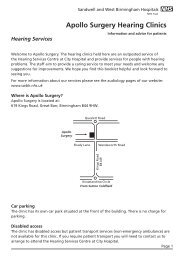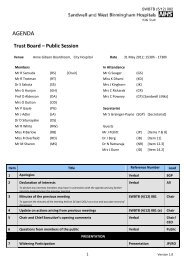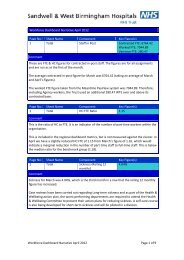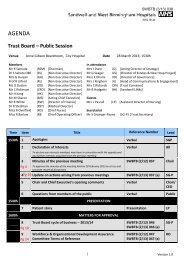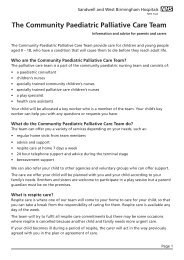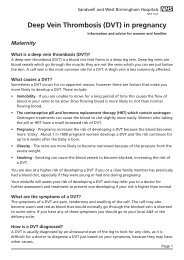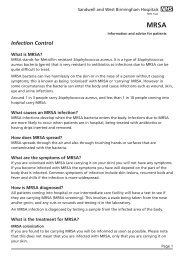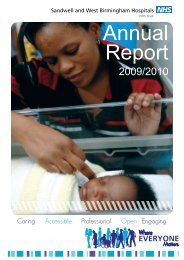Home oxygen therapy - Sandwell & West Birmingham Hospitals
Home oxygen therapy - Sandwell & West Birmingham Hospitals
Home oxygen therapy - Sandwell & West Birmingham Hospitals
You also want an ePaper? Increase the reach of your titles
YUMPU automatically turns print PDFs into web optimized ePapers that Google loves.
<strong>Home</strong> <strong>oxygen</strong> <strong>therapy</strong><br />
Information and advice for patients<br />
Community Respiratory Service<br />
delivers the <strong>oxygen</strong> through tubing to a mask or prongs in your nose.<br />
Using an <strong>oxygen</strong> concentrator should not stop you from moving about your house. You<br />
can have up to 50 feet of tubing, which should be as much as you need to move about<br />
your home freely. Otherwise you can have the tubing plumbed in around the home, which<br />
reduces the risk of tripping over the tubing. If you would like these adjustments to your<br />
tubing, please contact your <strong>oxygen</strong> supplier.<br />
You will be reimbursed for the cost of the electricity used to power your <strong>oxygen</strong> concentrator<br />
(Air Products will give you information on this) and will also be given a back-up <strong>oxygen</strong><br />
cylinder to use in case of a problem with your electricity supply.<br />
Ambulatory device<br />
An ambulatory (mobile) <strong>oxygen</strong> device may be a small cylinder, portable <strong>oxygen</strong> machine or<br />
liquid <strong>oxygen</strong> device which is for use during activities that make you the most breathless and<br />
tired, not when you are resting. You will have had a walk test at the <strong>oxygen</strong> clinic to see how<br />
much <strong>oxygen</strong> you need when walking.<br />
Air Products will supply the equipment you need for this and you should contact them when<br />
the <strong>oxygen</strong> cylinder needs changing.<br />
How long will I need home <strong>oxygen</strong> <strong>therapy</strong> for?<br />
If you are having <strong>oxygen</strong> <strong>therapy</strong> because you have a long-term condition you will need to<br />
use the <strong>oxygen</strong> permanently. If you are having <strong>oxygen</strong> for a short-term illness you may not<br />
need it once you have recovered. You will be given follow-up appointments to check that the<br />
amount of <strong>oxygen</strong> you are receiving is correct.<br />
How do I know if I am receiving enough <strong>oxygen</strong>?<br />
The only way to know that you are receiving enough <strong>oxygen</strong> is by having a specialist <strong>oxygen</strong><br />
assessment. You will not be able to know any other way because breathlessness is not related<br />
to how good your <strong>oxygen</strong> levels are; you can be severely breathless and have good <strong>oxygen</strong><br />
levels or you mildly breathless with low <strong>oxygen</strong> levels.<br />
If you think you are not getting enough <strong>oxygen</strong> please contact the Community Respiratory<br />
Service to discuss this.<br />
Going on holiday<br />
If you are going on holiday in this country, you can order a supply of <strong>oxygen</strong> to take with<br />
you by contacting Air Products. You will need to tell them your holiday dates and the<br />
address, telephone number and contact name for the place you will be staying. Your <strong>oxygen</strong><br />
will be delivered to where you are staying on the day you arrive and will be taken away on<br />
the day you leave.<br />
Page 3




